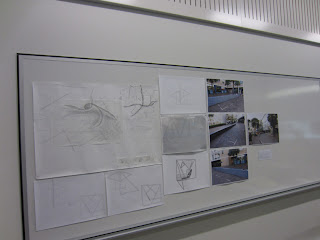The final
project for my other studio class was to pick a specific site within my
university, and, having analysed it through applying ‘Goethean scientific
methodology’, improve it.
My space
chosen was effectively dead space, a place where no one felt welcome to relax
or to meet, and a place that lacked suitable seating despite being well
positioned as a mid-campus ‘pitt stop’.
We were to
undertake an iterative process and to develop our ideas specifically through
model making.
My key aims
were to provide: seating, a welcoming area, and shelter.
My first
model provided bench seating as well as a ‘wind shield’ due to the area often
resembling a wind tunnel.
Moving on
from that I created an Olafur Eliasson-inspired tunnel to make the path nearby
more interesting and engaging. Thus tunnel also came about due to Paul
Jackson’s 2011 book Folding Tecniques for
Designers: From Sheet to Form.
Moving away
from that idea, and after experimenting with folded cardboard I formed this
shape.
When I moved
the two side elements of this design around I noted its resemblance to a moth
and so decided to enhance this. The lines in the ‘wings’ were experiments for
in-built seating.
From the moth
idea came the notion of having a light bulb moment, yet initial drawings of a
giant light bulb monument revealed this to be impractical. Nonetheless, I liked
the idea of creating some kind of sculptural form along with seating.
I moved away
from cardboard and began to experiment with geometric forms and balsa wood.
Yet I still wanted
the area to be practical and so I returned to a simple bench seat with a cover.
I then
combined these ideas, albeit in a chaotic kind of way.
I once more
returned to the idea of benches and created two variations.
From this I
formed a frame with sheltered areas. With this formed, I experimented, again,
with types of seating.
I was pleased
with the frame and so built a copy on which I attached the reclining seats of
the final model. This model provides seating and shelter while also being
site-specific within the university and due to its placement outside a
bookshop, as the frame and shape of the seat reflects the shape of an open
book.
And finally, here are the presentation boards displaying an A1 abstract spatial analysis, photographs of the site, plans, elevations, sections and renderings of the final design.























































